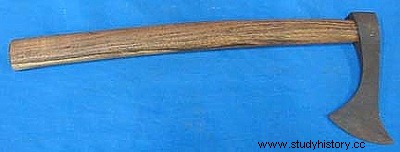
The francisque is a throwing ax that was used by the Merovingian and Carolingian Franks between the 5th and 8th centuries.
Etymology
The name francisca appears for the first time in the book Etymologiarum sive originum, libri XX by Isidore of Seville (v.570 – 636). It is the feminine of the adjective franciscus (from francus, "franc"), noun after elision of a noun like securis, "axe".
Description
Archaeological evidence indicates that Frankish warrior elites commonly used the francisque (it was uncommon among rank and file soldiers). The soldiers would have thrown it from a distance of about ten to twelve meters. The ax blade was heavy in order to produce a large impact on the target, but since the weapon was not balanced like a javelin can be, the francisque did not have a very regular trajectory, reducing the range and precision.
The francisque can be recognized by the characteristic S-shaped curvature of the tip of the blade, the lower edge of the blade curving inwards and then forming a bend with the handle. The center of the iron forms an angle of approximately 90 to 115° with the shaft. Most francisques have a round or teardrop eye for the passage of a tapered handle, similar to that of Viking axes and tomahawks. Most francisque blades are between eleven and twenty-two centimeters long and weigh between 200 and 1,300 grams.
In the French colony of North America, the tomahawk was, so to speak, an updated francisque.
The Vichy regime used in its iconography the image of a stylized double francisco — to be compared to the fasces of lictors.
Presentation
Country of origin Western Europe
Type throwing ax
User(s) Merovingian and Carolingian Franks
Period of use 5th → 8th century
Weights and dimensions
Mass 200 to 300 g
Blade length 11 to 22 cm
Materials iron, wood
Span 10 to 12m
